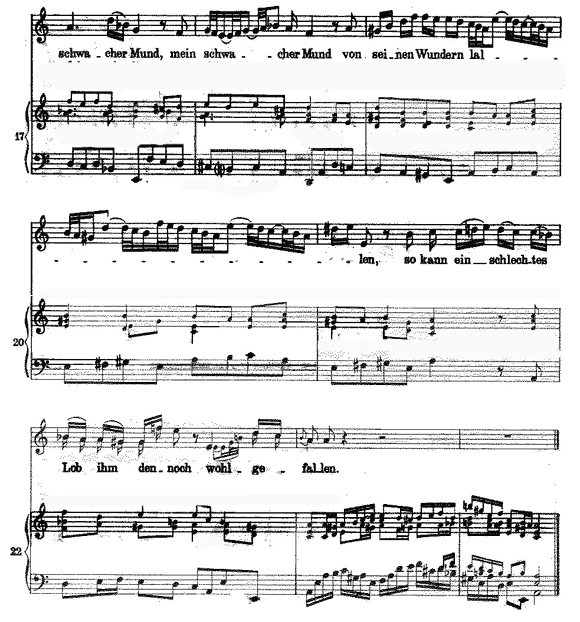A solo cantata written for the 15th Sunday after Trinity, and presumably used for other joyful occasions, as Bach writes “et In ogni Tempo” (for any occasion) as the subheading. This was likely written in 1730 and first performed on September 17 of that year. This is one of only twelve cantatas which require only solo voice, and one of only nine which do not have at least an SATB ensemble, let alone a full choir.
The work is scored for solo soprano and solo trumpet accompanied by strings, a common Italian scoring, used by composers such as Alessandro Scarlatti and Alessandro Stradella, among others. It is set in five movements:
| Movt. | Scoring | Meter and tempo | Key | Form or Genre |
| Aria | Soprano, trumpet, strings, continuo | 4/4, brisk | C major [implies F, a minor, e minor, G] | Da capo aria |
| Recitative | Soprano, strings, continuo | 4/4, slow to moderate [Andante is marked in the middle] | a minor [implies C, e minor, f minor, d minor] | Binary [2 clear sections, neither repeated] |
| Aria | Soprano, continuo | 12/8, moderate | a minor [implies C, d minor, G, e minor, F] | Dal segno aria |
| Chorale | Soprano, 2 solo violins, continuo | 3/4, moderate to fast | C major [implies G, d minor, e minor, a minor, F] | Chorale fantasy |
| Aria | Soprano, trumpet, strings, continuo | 2/4, fast | C major [implies G, d minor, a minor, F] | Through-composed |
This is quite a showcase and a workout for the soprano, who
- must carry most of the melodic material in all five movements (fortunately, the violins and trumpets occasionally spell a rest for her);
- must have a light, flexible voice for the quick, virtuosic passage work, especially in the final movement;
- must have a large range, covering two octaves (middle C to two octaves above that); and
- can add vocal ornamentation in the two da capo arias (movement 1 and the dal segno aria, movement 3), which would be expected in Baroque performance practice
Because of this, this cantata is well-suited for concert, rather than church, performance. In fact, one wonders how Bach was able to pull this work off during his lifetime; a boy soprano would have had to work awfully hard to compete with the trumpet part – even thinking of the softer trumpets of Bach’s day (women didn’t sing in church in Bach’s time) – and the high C would have been out of reach of many. Simon Heighes thinks that Christoph Nichelmann (1717-1762), a particularly gifted singer who came to the Thomasschule the same year this cantata was written, may have been the singer, though clearly a professional-quality performer is needed. Another possibility was the castrato Giovanni Bindi, who Bach may have heard in nearby Dresden. The difficult trumpet writing was probably intended for Bach’s friend Gottfried Reiche, as were many of Bach’s trumpet parts.
The text of the second movement is based on Psalms 138 and 26. This is not the kind of recitative we’re used to hearing, as it is a fully accompanied recitative with a very melodic vocal part, what we would characterize really as an arioso. Look at some of the complicated melismatic writing here:

Notice the melisma on the word “schwacher” (faltering) and “lallen” (stammer). Also see the chromatic, twisted passage to conclude the movement. Is this indicative of the final sentence of the text?
| Muß gleich der schwache Mund Von seinen Wunern lallen, So kann ein schlechtes Lob Ihm dennoch wohlgefallen. |
Although the mouths are feeble Which stammer about His wonders, Even such poor praise Can be pleasing to Him. |
Is this our continuing babbling? Wandering, attempting to articulate what we cannot? Yet, by reaching a traditional cadence, we realize that this effort alone is still pleasing to God?
The third movement is a dal segno aria, similar to the da capo aria in that it is an ABA form, but instead of returning to the very opening, the singer returns to the sign, which looks in the score like an S with a slash through it, plus two dots. This movement provides stark contrast to the opening aria, which was joyful, boisterous, jubilant, and strongly in C Major. This movement is more gentle, contemplative, almost prayerful, and set in a minor.
The cantata closes with a chorale, which was common of course among Bach’s works, but unusually this concludes with a chorale fantasy, rather than with a traditional four-part arrangement. The orchestra weaves a complicated texture while the singer presents the chorale tune in long notes, with occasional ornaments as the cadence nears.


































